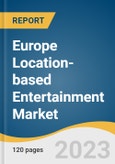Technological advancements such as virtual reality, augmented reality, and mixed reality have greatly enhanced the capabilities of amusement parks and arcade studios, allowing for more immersive and interactive experiences. VR arcades, escape rooms, and theme parks with AR/MR elements are gaining popularity, providing growth opportunities for the market.
The key players operating in the market include Cinepolis; Walt Disney Parks and Resorts; Universal Studios Park and Resorts; Barron Games; and others. Some of the key players providing entertainment technology solutions include Microsoft Corporation; Google, Inc.; HTC Corporation; IMAX Corporation; HQ Software; Magic Leap; and VRstudios, Inc. These companies are focusing on technological developments, launching new products and services, and forming strategic alliances to gain a competitive edge in the industry.
For instance, Merlin Entertainment owns and operates several Legoland theme parks in Europe, including Legoland Windsor in the U.K., and Legoland Deutschland in Germany. These parks offer immersive experiences centered on the iconic Lego brand, with rides, shows, and interactive attractions.
Moreover, the growing adoption of advanced technologies such as VR, AR, and MR has opened new possibilities for high-end experiences. VR arcades and gaming centers have gained popularity, allowing users to explore virtual experiences. Escape rooms have capitalized on the trend, combining physical puzzles with digital storytelling to create immersive adventures.
The market shows promising prospects for further growth and innovation. The advancements in technology, particularly in VR, AR, and MR, will continue to drive the development of more immersive and realistic experiences. As the cost of these technologies’ decreases, these venues will become more accessible to a broader audience, leading to increased market penetration.
European consumers are increasingly seeking out unique and memorable experiences. They are willing to spend on entertainment attractions that offer high-quality content, interactivity, and immersive storytelling. Amusement parks and arcade studios that can meet and exceed consumer expectations are likely to thrive in the market. Additionally, consumers are becoming more discerning, seeking out experiences that are socially interactive, personalized, and aligned with their interests.
Collaborations with popular Intellectual Properties (IPs) of the company, including movies, TV shows, video games, and cultural franchises, can significantly impact the European market. Licensed attractions and themed experiences based on well-known IPs tend to attract a larger audience due to existing fan bases and the allure of experiencing a beloved story or world in a new way. Strong partnerships with IPs can help them to differentiate themselves and drive footfall.
Social media has significantly shaped consumer expectations and driven demand for immersive experiences on platforms like Instagram, TikTok, and YouTube. Immersive entertainment attractions provide visually stunning and shareable content that can generate excitement and draw more visitors. Immersive experiences in entertainment attractions have broad appeal across various age groups and demographics.
Families, teenagers, young adults, or tourists all remain potential customers of immersive attractions, which have the potential to cater to a wide range of interests and preferences. This versatility helps drive the growing demand and ensures a diverse customer base. Immersive experiences offer a level of novelty and innovation that can attract both new and repeat customers.
These businesses that continuously invest in cutting-edge technologies and creative concepts can stay ahead of the competition and capture consumer attention, who are seeking something fresh and exciting. It is often integrated with other forms of entertainment, such as live performances, interactive exhibits, or gamified elements.
Europe Location-based Entertainment Market Report Highlights
- The hardware segment accounted for a revenue share of around 64.0% in 2022. The growth of the hardware segment can be attributed to the increasing demand for hardware components driven by the technological advancements in the VR/AR-based gadgets
- Significant advancements in 3D animation, 3D mapping, and other 3D technologies are driving the adoption of 3D technology in LBE. Following the 3D segment, the Cloud Merged Reality (CMR) segment is also growing at a fast pace
- Germany accounted for a significant market share in 2022. The country is a popular tourist destination, attracting millions of international visitors annually. The country's rich cultural heritage, historic sites, and vibrant cities provide ample opportunities for LBE attractions
Table of Contents
Companies Mentioned
- Microsoft Corporation
- Google Llc
- Hq Software
- Htc Corporation
- Samsung Electronics Co. Ltd.
- Niantic Inc.
- Magic Leap Inc.
- Vrstudios Inc.
- Huawei Technologies Co. Ltd.
- Springboard Vr
- Cinepolis
- Disney Parks, Experience, And Products
- Universal Parks And Resorts
- Six Flags Entertainment Corporation
- Aeon Fantasy Company
- Barron Games International
- Kidzania Operations S.A.R.L.
Methodology

LOADING...
Table Information
| Report Attribute | Details |
|---|---|
| No. of Pages | 120 |
| Published | July 2023 |
| Forecast Period | 2022 - 2030 |
| Estimated Market Value ( USD | $ 911.6 million |
| Forecasted Market Value ( USD | $ 6681.6 million |
| Compound Annual Growth Rate | 28.4% |
| Regions Covered | Europe |
| No. of Companies Mentioned | 17 |









